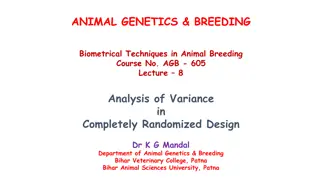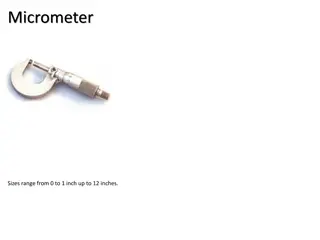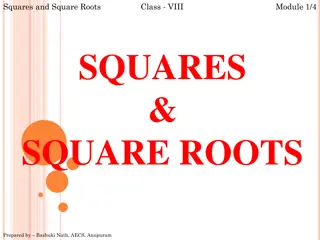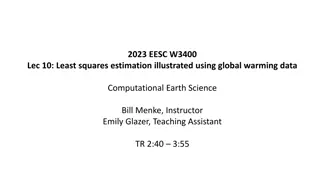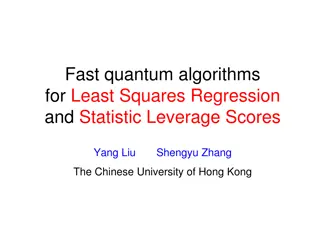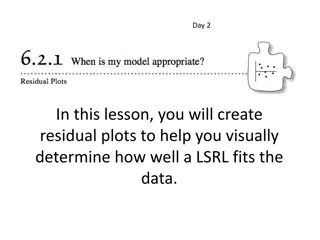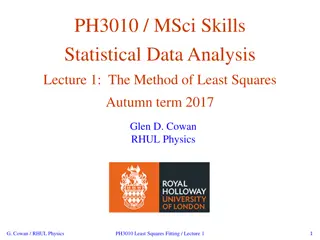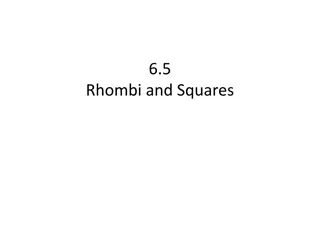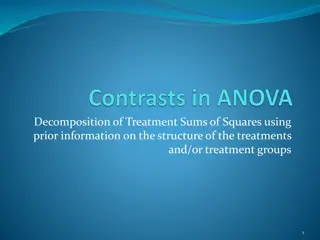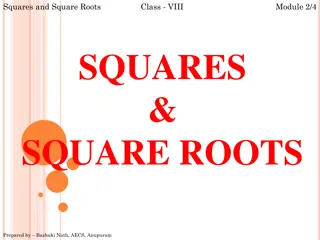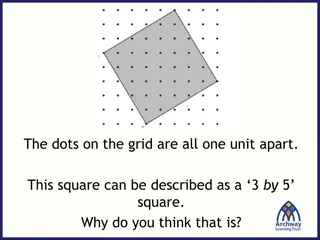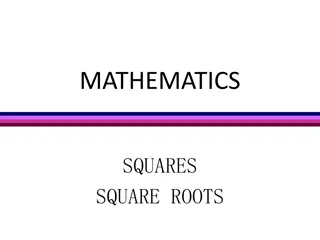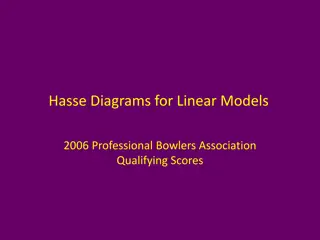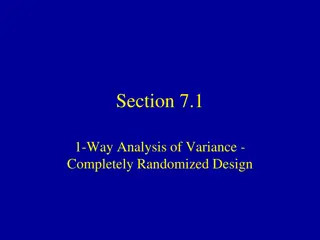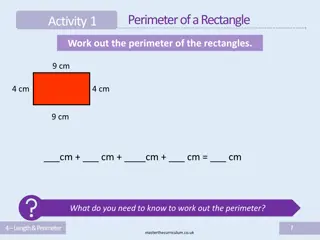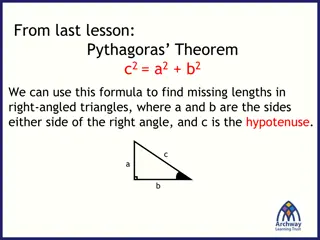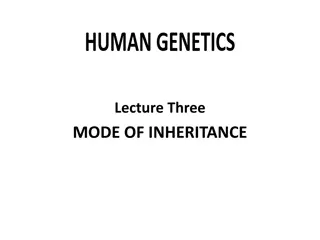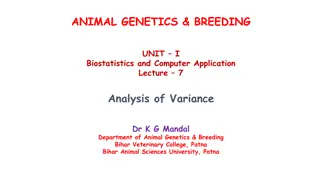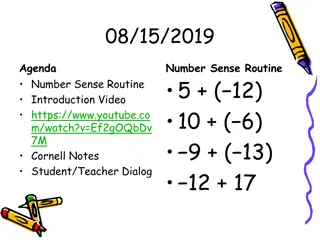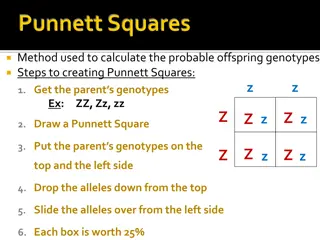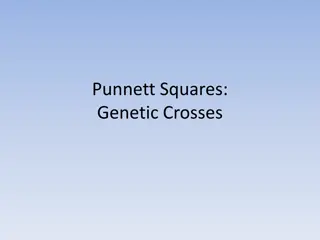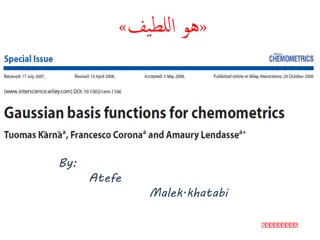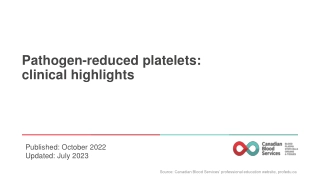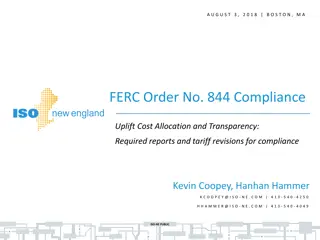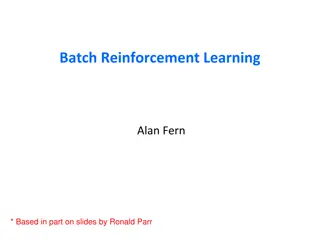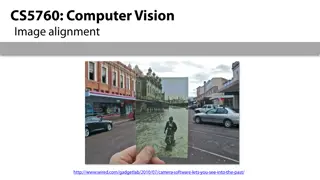Preconditioned Least-Squares Petrov-Galerkin Reduced Order Models Overview
Overview of the approach for model reduction in fluid and solid mechanics problems using Preconditioned Least-Squares Petrov-Galerkin (POD/LSPG). The method involves acquiring, reducing, and solving Ordinary Differential Equations (ODEs) by minimizing the residual through Proper Orthogonal Decomposition (POD). The benefits include improved stability, accuracy, and efficiency in handling high-fidelity models in various application areas like climate modeling and fastener failure analysis.
Download Presentation

Please find below an Image/Link to download the presentation.
The content on the website is provided AS IS for your information and personal use only. It may not be sold, licensed, or shared on other websites without obtaining consent from the author. Download presentation by click this link. If you encounter any issues during the download, it is possible that the publisher has removed the file from their server.
E N D
Presentation Transcript
Preconditioned Least-Squares Petrov- Galerkin Reduced Order Models for Fluid and Solid Mechanics Problems P R E S E N T E D B Y Payton Lindsay1, Jeff Fike1, Irina Tezaur1, Kevin Carlberg2 1Sandia National Labs, 2Meta Research Labs/U Washington ECCOMAS 2022 June 6-9, 2022 Oslo, Norway Sandia National Laboratories is a multimission laboratory managed and operated by National Technology & Engineering Solutions of Sandia, LLC, a wholly owned subsidiary of Honeywell International Inc., for the U.S. Department of Energy s National Nuclear Security Administration under contract DE-NA0003525. SAND2021-11141C
Motivation 2 Despite improved algorithms and powerful supercomputers, high-fidelity models are often too expensive for use in a design or analysis setting. Sandia application areas in which this situation arises: Captive-carry and re-entry environments: Large Eddy Simulations (LES) runs require very fine meshes and can take on the order of weeks. Fastener failure modeling: modeling fastener behavior in a full system presents meshing and computational challenges, which limits the number of configurations that can be studied. Climate modeling (e.g., land-ice, atmosphere): high-fidelity simulations too costly for uncertainty quantification (UQ); Bayesian inference of high-dimensional parameter fields is intractable.
POD/LSPG* Approach to Model Reduction 3 Full Order Model (FOM) = Ordinary Differential Equation (ODE): 1. Acquisition 3. Reduction Number of time steps Choose ODE Temporal Discretization Number of State Variables Reduce the number of unknowns Solve ODE at different design points 2. Learning Save solution data Proper Orthogonal Decomposition (POD): Minimize the Residual *Least-Squares Petrov-Galerkin Projection [K. Carlberg et al., 2011; K. Carlberg et al., 2017]
POD/LSPG* Approach to Model Reduction 4 Full Order Model (FOM) = Ordinary Differential Equation (ODE): 1. Acquisition 3. Reduction Number of time steps Choose ODE Temporal Discretization Number of State Variables Reduce the number of unknowns Solve ODE at different design points 2. Learning Save solution data Proper Orthogonal Decomposition (POD): Minimize the Residual Hyper-reduction/sample mesh *Least-Squares Petrov-Galerkin Projection [K. Carlberg et al., 2011; K. Carlberg et al., 2017]
POD/LSPG Approach to Model Reduction 5 Advantages of POD/LSPG projection: Computes a solution that minimizes the l2-norm of the time-discrete residual arising in each ? Ensures that adding basis vectors yields a monotonic decrease in the least-squares objective function defining the underlying minimization problem [Carlberg et al., 2011] Possesses better stability and accuracy than POD/Galerkin for certain classes of problems (e.g., compressible flow) [Carlberg et al., 2013; Carlberg et al., 2017; Tezaur et al., 2018]. Room for improvement for realistic predictive applications: FOM -- 1000 mode POD/LSPG ROM 2000 mode POD/LSPG ROM 3000 mode POD/LSPG ROM Accuracy for predictive problems can be inadequate Method may fail to converge for some realistic problems run in the predictive regime Pressure Method may struggle when applied to problems with disparate scales [Washabaugh, 2016] Reproductive Predictive Time Mitigation: introduction of preconditioning into LSPG ROM formulation.
Preconditioned LSPG ROMs 6 LSPG Formulation: Normal equations (?)= argmin 2 ||?(?)?? + ?(?)||2 (?)? ?PG (?):= ???? ???? ?:=???? ??(?) (?)= ?PG ? ? ?PG ?PG ?PG ?PG 2 ? ? ? 1+ ??? ?PG (?)=? ?PG ? = argmin ||? ?? ||2 (?)= ?PG (?) ? ? ?PG ?PG (?) Optimization problem Gauss-Newton iteration Preconditioned LSPG Formulation: Normal equations (?)= argmin 2 ||?(?)(?(?)?? + ?(?))||2 (?)? ?PG (?):= ???? ??? ?????? ?:=???? ??? ????(?) (?)= ?PG ? ? ?PPG ?PPG ?PPG ?PPG 2 ? ? ? 1+ ??? ?PPG (?)=? ?PPG ? = argmin ||?? ?? ||2 (?)= ?PPG (?) ? ? ?PPG ?PPG (?) Optimization problem Gauss-Newton iteration
Preconditioned LSPG ROMs Adding preconditioning to the POD/LSPG formulation can improve not only ROM efficiency but also ROM accuracy. 7 Ideal preconditioned ROM emulates projection of FOM solution increment onto POD basis. Upper limit on ROM accuracy is obtained by taking solution increment computed by FOM, ??(?), at each time step ? and projecting it onto the POD basis: (1) ? ?(?)= ?(???) 1????(?) Ideal preconditioned ROM(?(?)=(??) 1) gives rise to projected solution increment (1). As quality of preconditioner is improved (?(?) (??) 1), ROM solution approaches most accurate ROM solution possible for a given basis ?. Preconditioning can get different residual components on approximately the same scale. Minimizing the raw (unweighted) residual ? can be problematic for systems of PDEs where different variables have drasticallydifferent magnitudes (e.g., dimensional PDEs, multi-physics) [Washabaugh, 2016]. Adding a preconditioner can scale the ROM residual to get all the equations to be roughly of the same order. Preconditioning LSPG formulation changes the norm defining the residual minimization. Norm change can improve residual-based stability constant bounding ROM solution s error (?0,?1 1) . 1 ?0||?( ?)||2 | ? ? |2 1 ?1||?( ?)||2
Numerical Examples: Albany and SPARC codes 8 multi-physics finite element code SPARC4 Flow Solver Next-generation transonic and hypersonic C++ CFD code developed at Sandia Open-source1, parallel, C++ code Component-based design for rapid development Simulates compressible flow Contains a wide variety of constitutive models for mechanical/thermo-mechanical problems. Used for analyses involving captive carry and reentry vehicles Makes extensive use of libraries from the open- source Trilinos project2, including preconditioners from the Ifpack library Primary discretization is cell-centered finite volume method Leverages libraries from the Trilinos project2 Problems tested: quasi-staticmechanical and thermo-mechanical with prediction across material parameter space3. Problems tested: transient compressible laminar flow over an open cavity with prediction in time 1https://github.com/SNLComputation/Albany/releases/tag/MOR_support_end 2https://github.com/trilinos/trilinos 3P. Lindsay et al., IJNME,2022 (accepted), https://arxiv.org/abs/2203.12180 4Sandia Parallel Aerodynamics and Reentry Code
Table 2. Parameters in block ? for mechanical beam problem. Mechanical Beam (Albany) 9 ? ? 1 Mechanical problem involving Neohookean material 2 sets of material blocks, ? and ?, each having set of material params Material parameters in block ? are fixed Material parameters in block ? are varied (see Table 2) Linearly varying time-dependent pressure BC is prescribed on 1; other boundaries are fixed Problem is run quasi-statically to pseudo-time ? =7200s with 1340 dofs Training is performed for 6 sets of parameters; testing/prediction is performed for 4 sets of parameters (see Table 2) Nontrivial variations in displacement (up to 20%) are observed with the parameter variations considered (right figure) [Lindsay et al., in prep.]
Mechanical Beam (Albany) 10 Figure plots global relative error in approximate ROM solutions: ? ?=0 ?? ?? 2 ? ? ?=0 ?? 2 Preconditioners evaluated: Jacobi, Gauss-Seidel, ILU and (??) 1 (denoted by Ideal ) Nonlinear solver for unpreconditioned LSPG ROM did not converge for any of the basis sizes considered. More sophisticated preconditioners deliver smaller errors.
Mechanical Beam (Albany) 11 Figure plots condition numbers of reduced Jacobian (?PPG each ROM. (?) or ?PG (?)) for A moderate reduction in condition number is obtained through preconditioning strategies. Most sophisticated ILU preconditioner gives rise to a reduced Jacobian with the smallest condition number.
Mechanical Beam (Albany) 12 Figures shows CPU-times for all ROMs considered As expected, the projected solution increment is the most expensive to compute
Mechanical Beam (Albany) 13 The best preconditioner given error/CPU-time requirements can be inferred from Pareto plot shown here.
Thermo-Mechanical Beam (Albany) Table 3. Parameters in block ? for thermo-mechanical beam problem. 14 ? 2 ? 1 Coupled thermo-mechanical problem involving Neohookean material 2 sets of material blocks, ? and ?, each having set of material params Material parameters in block ? are fixed Material parameters in block ? are varied (see Table 3) Linearly varying time-dependent pressure and temperature BC is prescribed on 1 and 2, respectively; other boundaries are fixed Problem is run quasi-statically to pseudo-time ? =7200s with 2100 dofs Training is performed for 6 sets of parameters; testing/prediction is performed for 4 sets of parameters (see Table 3) Significant variations in displacement (up to 60%) are observed with the parameter variations considered (right figure) [Lindsay et al., in prep.]
Thermo-Mechanical Beam (Albany) 19 Figure plots condition numbers of reduced Jacobian (?PPG ROM. (?) or ?PG (?)) for each Reduced Jacobians for regular LSPG ROM are very ill-conditioned (> ? 1014) Ill-conditioning is due to extreme differences in scale b/w displacement and temperature solutions (9 orders of magnitude) Results demonstrate that simple preconditioning strategy can reduce condition numbers by as many as 10 orders of magnitude As expected, projected solution increment reduced Jacobian has perfect condition number
Thermo-Mechanical Beam (Albany) 20 Figures shows CPU-times for all ROMs considered In general, preconditioned LSPG ROMs achieve CPU-times smaller than unpreconditioned LSPG ROM As expected, the projected solution increment is the most expensive to compute in general
Thermo-Mechanical Beam (Albany) 21 Pareto plot results confirm that there is a significant computational advantage in applying preconditioning
Thermo-Mechanical Pressure Vessel (Albany) 22 Table 1. Parameters in block ? for thermo- mechanical pressure vessel problem. Coupled thermo-mechanical problem involving Neohookean material Multi-physics problem: temperature and displacement solutions differ by 9 orders of magnitude; 370K dofs 2 sets of material blocks, ? and ?, each having set of material params Material parameters in block ? (magenta, cyan) are fixed Material parameters in block ? (green, yellow, blue) are varied Pressure vessel is heated and pressurized from the inside Problem is run quasi-statically to pseudo-time ? =720s Testing 2 Testing 1 Training is performed for 4 sets of parameters; testing/prediction is performed for 2 sets of parameters (see Table 1) [Lindsay et al., IJNME, 2022 (accepted)]
Thermo-Mechanical Pressure Vessel (Albany) 23 Global relative error: ? ?=0 ?? ?? 2 ? Preconditioned (PC) LSPG ROMs are up to 5 orders of magnitude more accurate than LSPG ROMs. ? ?=0 ?? 2 Seven basis sizes evaluated: 2,4,8,16, 32,79,790 PC LSPG ROM LSPG ROM FOM LSPG ROMs do not converge for larger basis sizes. Accuracy is improved by improving the preconditioner.
Thermo-Mechanical Pressure Vessel (Albany) 24 Preconditioned LSPG ROMs are up to 12x faster than vanilla LSPG ROMs Top figures: CPU times More sophisticated preconditioners lead to greater CPU times Speed-ups are largely due to reduction in # nonlinear iterations (by factor of >12x) Bottom figures: # nonlinear iterations
Thermo-Mechanical Pressure Vessel (Albany) 25 Pareto plot confirms competitiveness of preconditioned LSPG ROMs.
Compressible Cavity Flow (SPARC) 26 2D viscous laminar flow around an open cavity geometry Simple model for the captive carry scenario Mach number = 0.6, Reynolds number 3000 Problem is run non-dimensionally Domain is discretized using 104,500 hexahedral cells (right) Of primary interest are long-time predictive simulations ROM is run at same parameters as FOM but much longer in time Relevant QOIs: statistics of the flow (e.g., pressure power spectral densities or PSDs) ?-axis ?-axis [Tezaur et al. 2017; Fike et al. 2018]
Compressible Cavity Flow (SPARC) 27 Figure top left: pressure time history for a point halfway up the downstream wall of the cavity for an LSPG ROM having 327 modes with a Jacobi preconditioner Figure bottom left: pressure PSD for the signal in the top left figure (solid line is mean PSD, shaded regions indicate range of values used to construct the mean) Preconditioned LSPG ROM captures well the pressure PSD, including its peaks (Rossiter modes) and the RMS OASPL1 Vanilla LSPG ROM did not run successfully Method RMS OASPL1 in dB % Difference from FOM FOM Ideal LSPG 66.176 67.552 N/A 68.033 2.08% N/A 2.80% LSPG + Jacobi PC 1Overall sound pressure level
Summary & Future Work 28 Summary: Adding preconditioning to the LSPG formulation gives rise to ROMs with improved accuracy and robustness, especially in the predictive regime Preconditioning attempts to emulate projection of FOM solution increment onto POD basis (the ROM best-case scenario for a given basis) Preconditioning can ensure all components of residual being minimized are of the same magnitude Preconditioning changes the norm in which the residual is minimized, which can improve residual-based stability constant bounding the ROM solution s error Results on predictive (across parameter space) thermo-mechanical and predictive (in time) compressible flow problems are compelling Ongoing/future work: Manuscript in preparation: J. Fike, P. Lindsay, K. Carlberg, I. Tezaur. Preconditioned Least-Squares Petrov- Galerkin Reduced Order Models for Compressible Flows , in prep. Application of preconditioned LSPG approach to more sophisticated problems relevant to Sandia s mission spaces Preconditioning LSPG ROMs has been helpful for hypersonic aero, thermal/ablation and reacting hypersonic flow problems
The End 29 For more details (mechanical/thermo-mechanical application), please see the following pre-print, which was just accepted for publication in IJNME: Thank you for your Attention!
30 Start of Backup Slides


